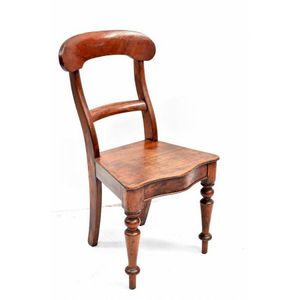George IV Rosewood Dining Chairs (Set of 6)
You must be a subscriber, and be logged in to view price and dealer details.
Subscribe Now to view actual auction price for this item
When you subscribe, you have the option of setting the currency in which to display prices to $Au, $US, $NZ or Stg.
- Rail - A term used by cabinet makers for the horizontal sections of the frame of an item such as a chair or settee which have a front rail, a back rail and two side rails, and also on a door or carcase, where the rails are joined to the vertical framings.
- Acanthus - A stylized leaf motif, one of the primary decorative elements of classical Greek and Roman architecture, derived from the genus of flowering plants in the family Acanthaceae, native to tropical and subtropical regions of the Mediterranean area. It is a common element in classical Greek and Roman design, and is often seen in Corinthian and Composite order columns and used as a decorative element in English, European and Australian furniture, particularly on the curve of a leg, and as decoration for a corbel.
- George Iv - George IV (1762 ? 1830) was king of the United Kingdom of Great Britain and Ireland and king of Hanover from 1820, until his own death in 1830. From 1811 until his accession in 1820, he served as Prince Regent during his father's final mental illness.
In English furniture design, his reign from 1811 to 1830 is known as the Regency period. - Turning - Any part of a piece of furniture that has been turned and shaped with chisels on a lathe. Turned sections include legs, columns, feet, finials, pedestals, stretchers, spindles etc. There have been many varieties and fashions over the centuries: baluster, melon, barley-sugar, bobbin, cotton-reel, rope-twist, and so on. Split turning implies a turned section that has been cut in half lengthwise and applied to a cabinet front as a false decorative support.
- Rosewood - A dense timber that varies in shade to very light brown to almost black. When rosewood is cut and sanded the colour of the timber will turn black, and after polishing and exposure to daylight, the surface will gradually lighten over time to light brown with black streaks.
The name comes from the odour emanating from the timber when it is planed, sanded or cut.
Rosewood was very popular for use in Victorian furniture in the second half of the 19th century, and at that time most of the rosewood was imported from Brazil. However it also grows in India and Indonesia.
It is used in the sold for chairs and table legs, but for carcase furniture such as side cabinets and bookcases, and for table tops it is always used as a veneer.
This item has been included into following indexes:
- chairs, sets of 6, style or period
-
chairs, sets of 6, timber
- all styles and timbers 737
- rosewood 29
Visually similar items

Three Australian Colonial cedar dining chairs, each with a curved top rail, on turned tapering legs, two with burgundy leather drop-in seats and the other with green leatherette drop-in seat (3), height 92 cm


A spade back carver chair, Australian cedar, N.S.W. origin, circa 1860 51 cm across the arms

Set of ten Regency mahogany chairs, c. 1820, comprising eight dining chairs and two carvers, each with curved rectangular top rail with ebony string inlay above carved cross-rail, over burgundy leather seat, raised on two turned and reeded front legs and t
